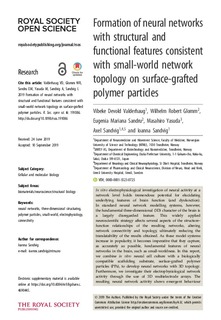| dc.contributor.author | Valderhaug, Vibeke Devold | |
| dc.contributor.author | Glomm, Wilhelm | |
| dc.contributor.author | Sandru, Eugenia Mariana | |
| dc.contributor.author | Yasuda, Masahiro | |
| dc.contributor.author | Sandvig, Axel | |
| dc.contributor.author | Sandvig, Ioanna | |
| dc.date.accessioned | 2019-10-24T10:51:43Z | |
| dc.date.available | 2019-10-24T10:51:43Z | |
| dc.date.created | 2019-10-23T10:06:04Z | |
| dc.date.issued | 2019 | |
| dc.identifier.citation | Royal Society Open Science. 2019, 6 (10), . | nb_NO |
| dc.identifier.issn | 2054-5703 | |
| dc.identifier.uri | http://hdl.handle.net/11250/2624118 | |
| dc.description.abstract | In vitro electrophysiological investigation of neural activity at a network level holds tremendous potential for elucidating underlying features of brain function (and dysfunction). In standard neural network modelling systems, however, the fundamental three-dimensional (3D) character of the brain is a largely disregarded feature. This widely applied neuroscientific strategy affects several aspects of the structure–function relationships of the resulting networks, altering network connectivity and topology, ultimately reducing the translatability of the results obtained. As these model systems increase in popularity, it becomes imperative that they capture, as accurately as possible, fundamental features of neural networks in the brain, such as small-worldness. In this report, we combine in vitro neural cell culture with a biologically compatible scaffolding substrate, surface-grafted polymer particles (PPs), to develop neural networks with 3D topology. Furthermore, we investigate their electrophysiological network activity through the use of 3D multielectrode arrays. The resulting neural network activity shows emergent behaviour consistent with maturing neural networks capable of performing computations, i.e. activity patterns suggestive of both information segregation (desynchronized single spikes and local bursts) and information integration (network spikes). Importantly, we demonstrate that the resulting PP-structured neural networks show both structural and functional features consistent with small-world network topology. | nb_NO |
| dc.language.iso | eng | nb_NO |
| dc.publisher | The Royal Society | nb_NO |
| dc.rights | Navngivelse 4.0 Internasjonal | * |
| dc.rights.uri | http://creativecommons.org/licenses/by/4.0/deed.no | * |
| dc.title | Formation of neural networks with structural and functional features consistent with small-world network topology on surface-grafted polymer particles | nb_NO |
| dc.type | Journal article | nb_NO |
| dc.type | Peer reviewed | nb_NO |
| dc.description.version | publishedVersion | nb_NO |
| dc.source.pagenumber | 10 | nb_NO |
| dc.source.volume | 6 | nb_NO |
| dc.source.journal | Royal Society Open Science | nb_NO |
| dc.source.issue | 10 | nb_NO |
| dc.identifier.doi | https://doi.org/10.1098/rsos.191086 | |
| dc.identifier.cristin | 1739752 | |
| dc.description.localcode | © 2019 The Authors. Published by the Royal Society under the terms of the Creative Commons Attribution License http://creativecommons.org/licenses/by/4.0/, which permits unrestricted use, provided the original author and source are credited. | nb_NO |
| cristin.unitcode | 194,65,30,0 | |
| cristin.unitname | Institutt for nevromedisin og bevegelsesvitenskap | |
| cristin.ispublished | true | |
| cristin.fulltext | original | |
| cristin.qualitycode | 1 | |

